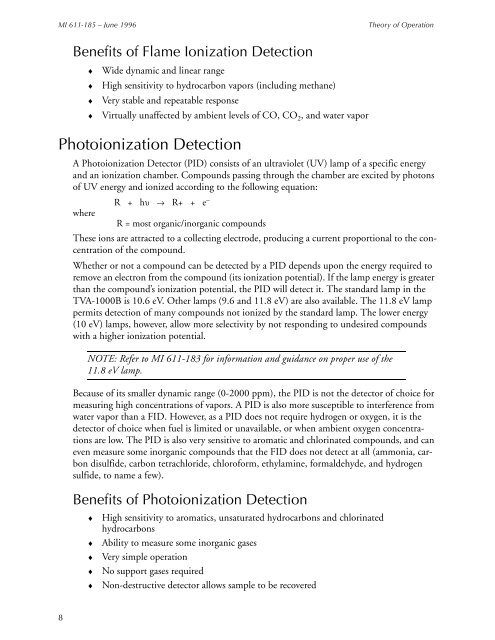Thermo Scientific TVA-1000B Instruction Manual - Geotech ...
Thermo Scientific TVA-1000B Instruction Manual - Geotech ...
Thermo Scientific TVA-1000B Instruction Manual - Geotech ...
Create successful ePaper yourself
Turn your PDF publications into a flip-book with our unique Google optimized e-Paper software.
MI 611-185 – June 1996<br />
Theory of Operation<br />
Benefits of Flame Ionization Detection<br />
♦<br />
♦<br />
♦<br />
♦<br />
Wide dynamic and linear range<br />
High sensitivity to hydrocarbon vapors (including methane)<br />
Very stable and repeatable response<br />
Virtually unaffected by ambient levels of CO, CO 2 , and water vapor<br />
Photoionization Detection<br />
A Photoionization Detector (PID) consists of an ultraviolet (UV) lamp of a specific energy<br />
and an ionization chamber. Compounds passing through the chamber are excited by photons<br />
of UV energy and ionized according to the following equation:<br />
R + hυ → R+ + e –<br />
where<br />
R = most organic/inorganic compounds<br />
These ions are attracted to a collecting electrode, producing a current proportional to the concentration<br />
of the compound.<br />
Whether or not a compound can be detected by a PID depends upon the energy required to<br />
remove an electron from the compound (its ionization potential). If the lamp energy is greater<br />
than the compound’s ionization potential, the PID will detect it. The standard lamp in the<br />
<strong>TVA</strong>-<strong>1000B</strong> is 10.6 eV. Other lamps (9.6 and 11.8 eV) are also available. The 11.8 eV lamp<br />
permits detection of many compounds not ionized by the standard lamp. The lower energy<br />
(10 eV) lamps, however, allow more selectivity by not responding to undesired compounds<br />
with a higher ionization potential.<br />
NOTE: Refer to MI 611-183 for information and guidance on proper use of the<br />
11.8 eV lamp.<br />
Because of its smaller dynamic range (0-2000 ppm), the PID is not the detector of choice for<br />
measuring high concentrations of vapors. A PID is also more susceptible to interference from<br />
water vapor than a FID. However, as a PID does not require hydrogen or oxygen, it is the<br />
detector of choice when fuel is limited or unavailable, or when ambient oxygen concentrations<br />
are low. The PID is also very sensitive to aromatic and chlorinated compounds, and can<br />
even measure some inorganic compounds that the FID does not detect at all (ammonia, carbon<br />
disulfide, carbon tetrachloride, chloroform, ethylamine, formaldehyde, and hydrogen<br />
sulfide, to name a few).<br />
Benefits of Photoionization Detection<br />
♦<br />
♦<br />
♦<br />
♦<br />
♦<br />
High sensitivity to aromatics, unsaturated hydrocarbons and chlorinated<br />
hydrocarbons<br />
Ability to measure some inorganic gases<br />
Very simple operation<br />
No support gases required<br />
Non-destructive detector allows sample to be recovered<br />
8

















